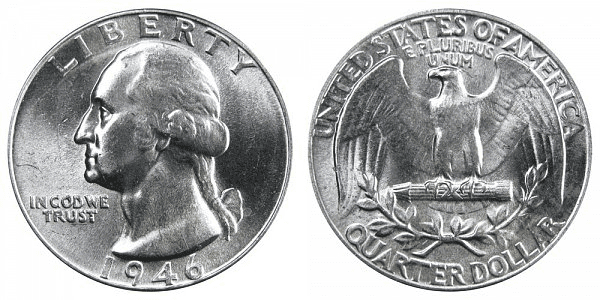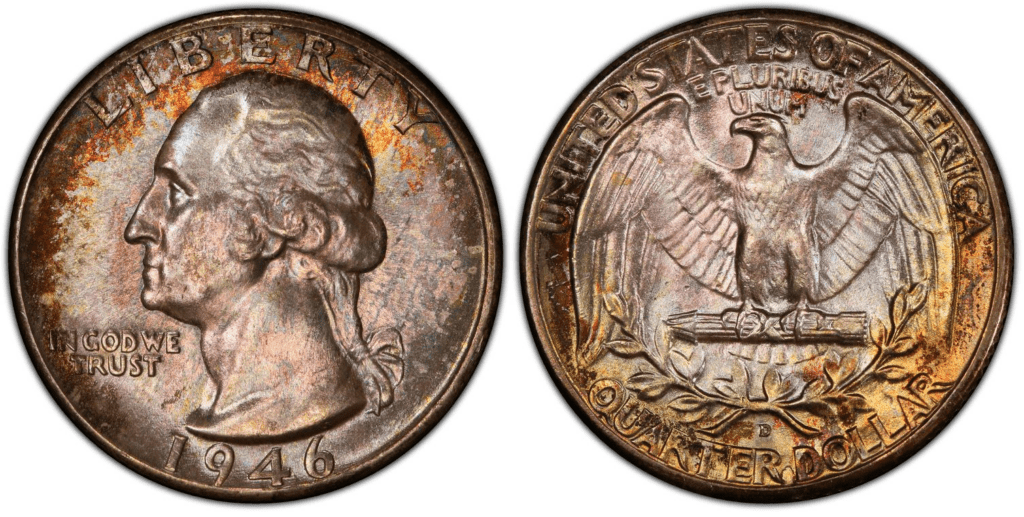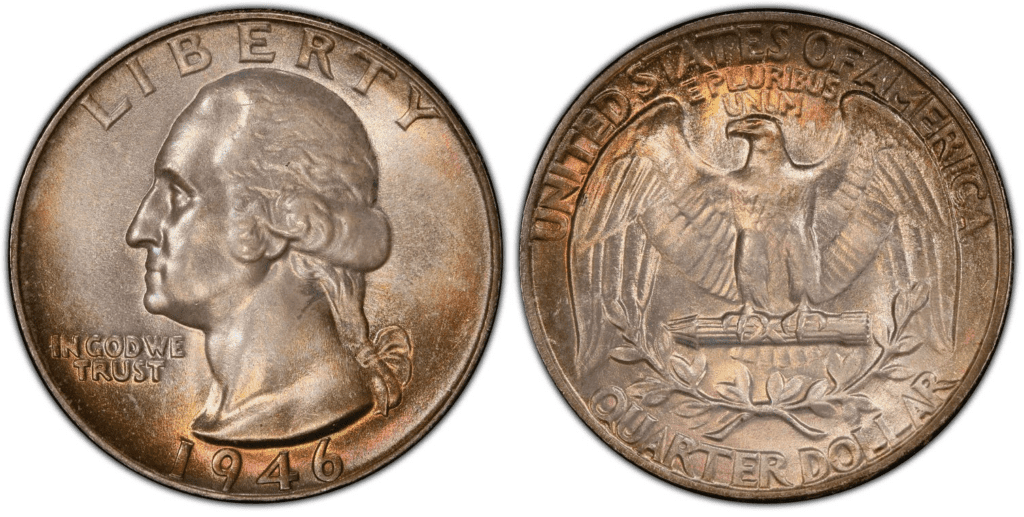What Is the 1946 Washington Quarter Made Of?
The Washington quarter is the current 25-cent piece of the United States. But did you know that it should have been issued for just a year, only in 1932? However, its coinage continued and permanently replaced the Standing Liberty quarter.
You can read more about our subject in this article guide — the 1946 Washington Quarter value. In addition, this guide provides more insights into the coin’s composition, history, price value, etc.
Known as the quarter, the 1946 Washington quarter coin has a face value of $0.25. The 1946 Washington quarter was made of 90 percent silver and 10 percent copper with a reeded edge. Its diameter was 24.30 mm, while its weight was 6.25 grams.
Beginning in 1965, all Washington Quarter coins were composed of cupronickel clad to copper. However, there are still existing silver coins for collection in 1974.
In 1932, the bicentennial committee established by Congress decided to commemorate the bicentennial birth anniversary of the U.S. first President George Washington. Accordingly, they planned to displace the Walking Liberty fifty-cent at that time.
However, Congress permanently replaced the Standing Liberty quarter instead. In addition, the committee instructed to have the President’s profile depict the quarter coin. Since then, the quarter dollar features Washington on the coin’s obverse.

The decision to design the Washington quarter coin was contested. Initially, the Commission of Fine Arts supported sculptor Laura Gardin Fraser in designing Washington’s commemorative medal and adapting this design for the quarter.
However, Charles W. Moore and Treasury Secretary Andrew W. Mellon chose the design by John Flanagan. When Ogden L. Mills succeeded Mellon, he didn’t change Mellon’s decision to have Flanagan design the Washington quarter. Hence, John Flanagan’s design was announced in April 1932.
The obverse (face) side of the 1946 quarter depicts the U.S. first President George Washington profile with softly detailed hair tied in the back. His bust is facing the left. You can also find the following inscriptions on this side of the coin:
- LIBERTY
- IN GOD WE TRUST
- 1946
On the other hand, the reverse (tail) shows an eagle with its wings outspread. It perches on a bundle of arrows framed below by two olive branches. The reverse also has the following inscriptions:
- UNITED STATES OF AMERICA
- E PLURIBUS UNUM
- QUARTER DOLLAR
The Washington Quarter remains one of the most popular coins produced by the U.S. Mint. Being made of silver and because of its historical significance, the 1946 Washington Quarter is considered a sought-after coin by most collectors.
1946 Washington Quarter Varieties
Three minting facilities in the U.S., namely: Philadelphia, Denver, and San Francisco, struck Washington 25 cents in 1946. Overall, the three mints produced about 68 million Washington quarter coins that year.
The variety of the coin is determined by where it is minted. For example, the 1946 Washington quarters have three types: 1946-D, 1946-P, and 1946-S. To learn more about the specifications, look at the descriptions of each variety below:
1946 D Washington Quarter
Edge: Reeded
Mint Mark: D – situated between the olive branch and the QUARTER DOLLAR on the reverse
Place of minting: Denver
Year of minting: 1946
Face Value: $0.25 (twenty-five cents)
Price: $9 to $20 (or more)
Quantity produced:9,072,800
Designer: John F. Flanagan
Composition: 90% Silver, 10% Copper
Mass: 6.25 grams
Diameter: 24.30 mm

Towards the end of World War II, the Denver Mint struck 1946 Washington quarter cents with a little over 9 million. This was the first time the mint produced less than 10 million coins since 1940. There are relatively available MS66 conditions and large MS67 grade samples. Coins in Gem condition with good luster and strike are still somewhat obtainable.
1946 P Washington Quarter
Edge: Reeded
Mint Mark:No mint mark
Place of minting: Philadelphia
Year of minting: 1946
Face Value: $0.25 (twenty-five cents)
Price: $8 to $16 (or more)
Quantity produced: 53,436,000
Designer: John F. Flanagan
Composition: 90% Silver, 10% Copper
Mass: 6.25 grams
Diameter: 24.30 mm

The 1946 Washington ten-cent coins in Gem condition struck at the Philadelphia mint are hard to find. There were not as many Uncirculated grades in this series of ten cents as its mintage is relatively high. The 1946-P is noted to be scarcer than the 1946-S.
1946 S Washington Quarter
Edge: Reeded
Mint Mark: S – situated between the olive branch and the QUARTER DOLLAR on the reverse
Place of minting: San Francisco
Year of minting: 1946
Face Value: $0.25 (twenty-five cents)
Price: $11 to $55 (or more)
Quantity produced: 4,204,000
Designer: John F. Flanagan
Composition: 90% Silver, 10% Copper
Mass: 6.25 grams
Diameter: 24.30 mm

During the coinage of the Washington quarter cents from 1940 to 1964, the 1946-S recorded the second lowest mintage with only a little over 4 million coins struck. However, this variety has the most coins in Gem condition, and you can still find some of the best quality 1946-S existing to this day.
List Of 1946 Washington Quarter Errors
The 1946 Washington twenty-five cents are no exceptions egarding to minting-error coins. Of the 68 million produced in 1946, there are notable error coins.
One error during the minting of 1946 quarter coins was the doubled die on its reverse side. This happened when mistakes in the die hubbing process result in a double image struck in the planchet. It produces a partial or fully doubled image.
Another mint-made error is a cud error which results from a die break or die crack. Some 1946 Washington quarters have these errors, especially when an unintentional “blob” on the coin surface usually happens when there is a dent in the die.
So during minting, it’s no wonder when the machine deteriorates or malfunctions, coins exhibit errors creating a unique or distinct appearance. Nevertheless, these error coins are still desired by many collectors.
How Much Is The 1946 Washington Quarter Worth Today?
A 1946 Washington Quarter in Average Condition is estimated to be worth $6.25. The Uncirculated Mint Condition (MS) coins are worth as much as $8.38 to $47.
Its melt value depends on the silver and copper value when melted down. Currently, the 1946 Washington Quarters’ melt value is approximately $4.4.
By looking at the table below, you would find the value of the 1946 twenty-five cents based on its condition, grade, and mintage.
| Coin | Condition | Grade | Mintage | Value |
| 1946 D Washington Quarter | Circulated/mint | Not graded | 16,766,800 | $4.85 to $7.25 |
| 1946 D Washington Quarter | Uncirculated/mint | MS-66 | 16,766,800 | $23 to $70 |
| 1946 D Washington Quarter | Uncirculated/mint | MS-67 | 16,766,800 | $134 to $276 |
| 1946 D Washington Quarter | Uncirculated/mint | MS-68 | 16,766,800 | $3,450 to $3,738 |
| 1946 P Washington Quarter | Circulated/mint | Not graded | 35,196,000 | $4.95 to $7.50
|
| 1946 P Washington Quarter | Uncirculated/mint | MS-65 | 35,196,000 | $25 to $31 |
| 1946 P Washington Quarter | Uncirculated/mint | MS-66 | 35,196,000 | $36 to $100 |
| 1946 P Washington Quarter | Uncirculated/mint | MS-67 | 35,196,000 | $432 to $690 |
| 1946 S Washington Quarter | Circulated/mint | Not graded | 15,960,000 | $4.85 to $7.25 |
| 1946 S Washington Quarter | Uncirculated/mint | MS-66 | 15,960,000 | $38 to $576 |
| 1946 S Washington Quarter | Uncirculated/mint | MS-67 | 15,960,000 | $180 to $340 |
| 1946 S Washington Quarter | Uncirculated/mint | MS-68 | 15,960,000 | $1,162 to $11,400 |
As you can see, the 1946 Washington quarter can be valuable. However, wait until you see the auction records for each of the 1946 quarter varieties. You’ll soon realize how a 25-cent coin could be worth thousands of dollars:
- $14,950 – a 1946-S 25C (Regular Strike) coin with a grade of MS68 sold in January 2011 by Bowers & Merena
- $8,050 – a 1946 25C (Regular Strike) coin with a grade of MS67 sold in January 2003 by Heritage Auctions
- $6,463 – a 1946-D 25C (Regular Strike) coin with a grade of MS67 sold in July 2016 by Heritage Auctions
How Does The Grading System Work?
The Sheldon Scale is used by numismatists to provide a numerical value to coins. The Sheldon Scale goes from poor (P-1) to perfect mint state (P-1) (MS-70). Coins were originally evaluated using words to reflect their condition (Good, Fair, Excellent, Etc.). Unfortunately, coin collectors and dealers had different ideas about what each of these terms represent.
Professional numismatists joined together in the 1970s and established CoinGrading standards. These numismatists now assign grades at key places on the seventy-point scale, using the most regularly utilized numeric points in conjunction with the original adjective grade. The following are the most common coin grades:
-
-
- (P-1) Poor – Indistinguishable and probably damaged; if used, must have a date and mintmark; otherwise, rather battered.
- (FR-2) Fair – Nearly smooth, but without the damage that a coin graded Poor often possesses. The coin must have enough detail to be identified.
- (G-4) Fair – Inscriptions have merged into the rims in some areas, and important elements have been mostly erased.
- (VG-8) Very Good- A little weathered, but all of the primary design elements are visible, albeit faintly. There is little if any, central detail left.
- (F-12) Good – The item is very worn, yet the wear is even, and the overall design details stand out clearly. Rims are almost completely isolated from the field.
- (VF-20) Very Fine – Moderately weathered, with some finer features still visible. The motto or all letters of LIBERTY are readable. Both sides of the coin have entire rims that are separated from the field.
- (EF-40) Extremely Fine – Gently used; all gadgets are visible, and the most important ones are bold. The finer details are bold and clear, however, light wear may be seen.
- (AU-50) Uncirculated – Slight evidence of wear on the coin’s design’s high points; may have contact marks; eye appeal should be adequate.
- (AU-58) Uncirculated Choice – Slight traces of wear, no severe contact marks, almost full mint shine, and great eye appeal.
- (MS-60) Mint State Basal – Strictly uncirculated; no indication of wear on the coin’s highest points, but an unsightly coin with reduced luster, visible contact marks, hairlines, and other flaws.
- (MS-63) Mint State Acceptable – Uncirculated, but with contact scratches and nicks, little reduced shine, but otherwise appealing appearance. The strike is weak to average.
- (MS-65) Mint State Choice – Uncirculated with great mint shine, very little contact blemishes, and exceptional eye appeal. The strike is unusually severe.
- (MS-68) Mint State Premium Quality – Uncirculated with superb luster, no obvious contact marks to the naked eye, and exceptional eye appeal. The strike is quick and appealing.
- (MS-69) Almost Perfect Mint State – Uncirculated with perfect brilliance, a sharp and appealing strike, and extremely good eye appeal. A near-perfect coin with minor imperfections in the planchet, strike, and contact markings (seen only under 8x magnification).
- (MS-70) Mint State Perfect – Under 8x magnification, there are no tiny imperfections discernible; the strike is crisp, and the coin is perfectly centered on a beautiful planchet. Rarely seen on a coin, this coin is bright and whole, with original luster and exceptional eye appeal.
-
Where To Buy Or Sell 1946 Washington Quarter?
There are a lot of options for this! You can always find a good quality 1946 Washington Quarters on the web. When you Google search, for instance, you’d be redirected to eBay, Amazon, and other popular online stores. If you wish to sell online, you can also sign up on these sites.
If you like to be sure of a graded quality, sites specializing in coins, like JM Bullion, NGC, PCGS, etc., can give you an idea of how much and where to buy or sell a coin.
Also, if you’re on to traditional buying or selling and prefer to go to physical stores like pawn shops, coin stores, and auction houses are great options too, then check if they have available 1946 Washington Quarters or if they can buy your coin collections.
FAQs
How much is a 1946 quarter worth now?
At a current market price, a 1946 Washington Quarter could cost $4.90 to $7.50 in circulated condition. However, according to NGC pricing for 1946 Quarters in pristine and uncirculated condition, you can buy them for as much as $2950.
Is a 1946 Washington quarter pure silver?
No, the 1946 Washington quarter coins are made of 90% silver and 10% copper.
Are there any errors in the 1964 Washington quarter?
Yes, some known errors that struck the 1946 Washington quarter coins are doubled die or die cracks that caused cud errors.
Where is the mint mark on a 1946 Washington quarter?
For the 1946 Washington twenty-five cents, the mint marks are found on its reverse side. Coins struck in the Denver and San Francisco mints have “D” and “S” marks, respectively.
